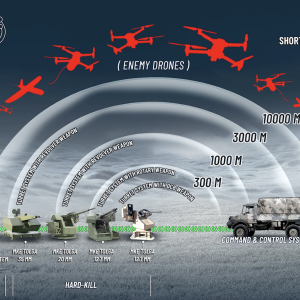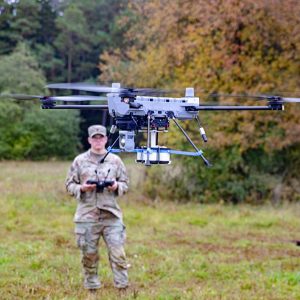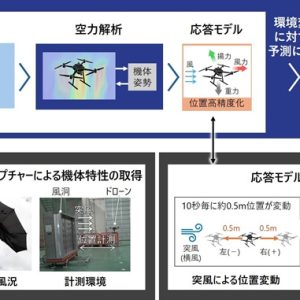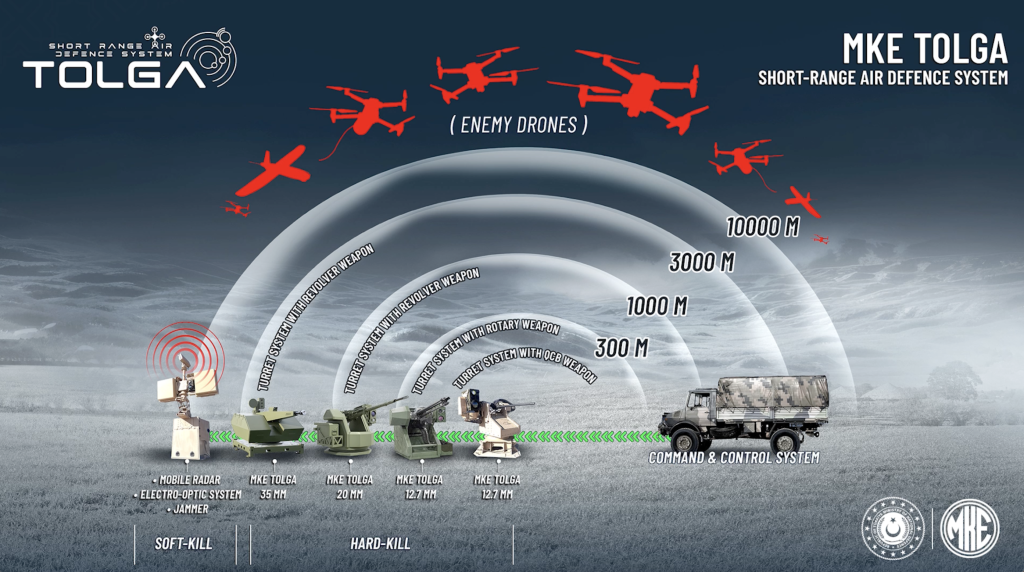
Türkiye’s state-owned defence manufacturer Makine ve Kimya Endüstrisi (MKE) has validated its new MKE TOLGA short-range air defence system with a 100% success rate during its first live-fire campaign at the Ministry of National Defence’s Karapınar Firing, Test and Evaluation Center. The trial shows how seriously Ankara now invests in layered counter-drone protection.
Nearly 100 representatives from the Turkish Armed Forces and security agencies attended the demonstration. The event showed TOLGA defeating hostile mini and micro UAVs, tactical drones and cruise-missile-like targets across eight different engagement scenarios. On a battlefield increasingly shaped by cheap, expendable drones, this debut performance positions MKE’s integrated solution as a credible, indigenous answer to a global capability gap.
Key facts: MKE TOLGA short-range air defence system
- 100% success in first live-fire test against eight different threat scenarios.
- Designed to counter mini/micro UAVs, tactical drones, smart munitions and cruise missiles.
- Soft-kill jamming engagements initiated at ranges of around 3 km.
- Multi-calibre hard-kill effectors: 35 mm, 20 mm and dual 12.7 mm weapon systems.
- Anti-drone ammunition forms a controlled fragment cloud around the target for efficient kills.
- Detection range of up to 10 km with integrated radar and electro-optical sensors.
- Modular architecture for land vehicles, fixed sites and naval platforms.
- Command and Control Unit supports manual, semi-autonomous and fully autonomous modes.
From concept to 100% live-fire success
MKE initially unveiled the TOLGA concept as a response to the rapid proliferation of commercial and military drones, particularly after the war in Ukraine normalised the use of FPV loitering munitions and low-cost strike systems. After this digital debut, the company pushed the system to full-scale live firing. The recent test provided the first comprehensive validation of its end-to-end engagement chain, from detection to neutralisation.
During the soft-kill scenario, the mobile radar station first detected a hostile drone at approximately 3 km. Operators then classified the contact as a threat and neutralised it through electronic attack. By disrupting the platform’s command, control and navigation links via its jammer suite, TOLGA defeated the unmanned threat without expending kinetic ammunition. That approach has become increasingly important for cost-effective defence against massed drone attacks.
In subsequent hard-kill scenarios, the system’s rotary and fixed 12.7 mm guns, together with the 20 mm cannon mounted on the TOLGA platform, engaged fixed-wing UAVs and FPV drones using specialised anti-drone ammunition that MKE developed. With precisely timed fuzing and controlled detonation distances, the rounds created a dense metal-particle cloud around each target and neutralised it without requiring a direct hit.
The 35 mm anti-drone ammunition provides effective engagement ranges up to 3,000 m. The 20 mm fragmenting round covers threats at around 1,000 m, while the 12.7 mm solution addresses targets at roughly 300 m. Together, these effectors give the MKE TOLGA short-range air defence system a layered, overlapping engagement envelope optimised for low, slow and small threats, including fibre-optic-controlled drones that operators cannot jam.

Following the test, MKE General Manager İlhami Keleş underlined that successfully completing all scenarios and neutralising targets with minimal ammunition has significantly strengthened the team’s confidence in the system and confirmed its readiness for mass production.
İlhami Keleş, General Manager, MKE
Keleş also linked TOLGA directly to Türkiye’s emerging “Steel Dome” concept and argued that the air and drone defence layer out to roughly 3 km now stands in place. In his view, TOLGA will close a critical gap for the Turkish Armed Forces and also position MKE to compete for export opportunities as allies and partners accelerate investments in counter-drone technologies.
Architecture and concept of operations
MKE designed the MKE TOLGA short-range air defence system as a tightly integrated system-of-systems that protects manoeuvre forces, critical infrastructure, convoys, forward operating bases and naval platforms at close range. The company federates radar, electro-optical sensors, electronic warfare units and weapon stations under a dedicated Command and Control Unit. This node handles detection, tracking, identification, engagement decisions and firing management.
Soft-kill and hard-kill effects in a single SHORAD suite
On the soft-kill side, TOLGA uses jamming to break or degrade the control and communication links of remotely operated drones as well as their satellite navigation signals. Detecting targets at distances of up to 10 km allows operators to initiate electronic attack well before threats reach defended assets. The system therefore offers a reversible, scalable and ammunition-free response against many commercial and improvised systems.
When soft-kill effects do not stop a threat, the system transitions to hard-kill engagement. The 35 mm, 20 mm and dual 12.7 mm weapon systems, fed with MKE’s proprietary anti-drone ammunition, create a layered kinetic envelope tailored to different threat classes and approach profiles. Engineers designed the ammunition to burst at the optimal time and distance and to disperse high-density fragments that form a lethal cloud around the drone.
This design significantly increases the probability of kill against agile, small cross-section targets while it uses fewer rounds per engagement. It also aligns with global efforts to field counter-drone options that cost less per shot than traditional surface-to-air missiles, which do not match the economics of low-cost UAV swarms.
Command, control and autonomy for complex airspace
The TOLGA Command and Control Unit functions as the brain of the system. It fuses data from radar and electro-optical sensors, applies identification and prioritisation logic, and then recommends or executes engagements depending on the selected mode. Operators can run TOLGA in fully manual, semi-autonomous or fully autonomous configurations. This flexibility helps commanders balance human oversight with reaction speed in contested, cluttered airspace.
From an integration standpoint, operators can install the system on fixed towers, wheeled or tracked armoured vehicles, unarmoured logistics platforms or naval vessels. This modularity is critical for future network-centric operations, where multiple TOLGA units can receive cues from higher-echelon surveillance assets and contribute to a wider integrated air and missile defence architecture.

Strategic relevance for Türkiye and allied partners
Across Europe and NATO, militaries urgently search for sustainable ways to counter the growing volume of low-cost unmanned systems. Routinely probe and violate allied airspace. From NATO’s dedicated counter-drone interoperability exercises to EU discussions around a high-tech “drone wall” along the eastern flank, a clear consensus has emerged. Armed forces need new families of short-range air defence systems to fill the gap between traditional air defence missiles and small-unit electronic warfare teams.
In that context, the MKE TOLGA short-range air defence system offers a compelling mix of capabilities. Its combination of wide-area detection, robust jamming and purpose-designed kinetic effectors provides commanders with an organic, scalable counter-UAS layer that they can deploy wherever the threat is highest. When integrated with Türkiye’s broader air and missile defence assets, TOLGA helps create a more continuous protective dome from very short ranges outward.
For Türkiye, the system also reinforces operational independence. MKE develops both the platform and its specialised anti-drone ammunition domestically, so supply chains and upgrade roadmaps remain under national control. That autonomy matters at a time when export controls and technology restrictions can still limit access to certain counter-drone solutions on the international market.
For potential export customers, TOLGA’s modular design and cost-conscious engagement philosophy will likely become key selling points. Many armed forces now seek systems that they can integrate rapidly into existing vehicles or infrastructure while still achieving predictable cost-per-engagement metrics that make sense against swarms of inexpensive drones. MKE’s long experience with naval guns and land-based weapon systems provides a solid industrial foundation for scaling production once domestic qualification is complete.
Doctrinal impact: normalising integrated counter-drone layers
Doctrinally, systems like TOLGA help normalise the idea that counter-drone defence sits at the core of modern air defence rather than at the margins. By combining soft-kill and hard-kill options on a single platform and enabling remote or autonomous operation, the MKE TOLGA short-range air defence system encourages planners to think in terms of persistent, distributed protection instead of ad-hoc, platform-by-platform fixes.
As Türkiye continues to refine its “Steel Dome” approach and allies in Europe move ahead with their own drone-defence initiatives, such integrated layers will shape not only procurement plans but also how units train, deploy and fight. The first live-fire campaign therefore marks a starting point for iterative upgrades, new effectors and increasingly networked operations rather than an end-state.
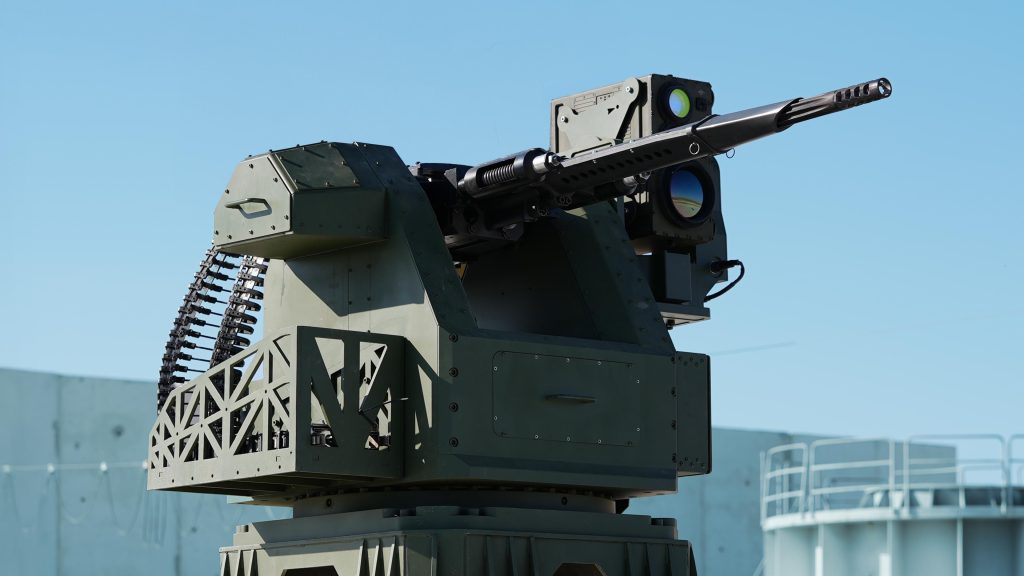
Conclusion: a new indigenous layer in counter-drone defence
The MKE TOLGA short-range air defence system achieved 100% success during its debut live-fire test, a significant milestone in its development. More importantly, the system combines radar, electro-optics, electronic warfare, multi-calibre guns and specialised ammunition in a coherent, modular architecture that directly addresses the hardest problems posed by today’s drone-saturated battlefields.
As MKE moves TOLGA into serial production and continues live demonstrations for friendly and allied nations, the system stands ready to become a central pillar of Türkiye’s close-in air and drone defence posture. At the same time, it offers partners a mature, field-tested option for protecting forces, convoys, bases and critical infrastructure against the full spectrum of small unmanned threats.
For defence planners and industry alike, TOLGA’s first live-fire campaign sends a clear signal. The race to build resilient, affordable and layered counter-drone architectures has entered a new phase, and Türkiye intends to sit among the countries that shape that future.
Further Reading
For readers who want to explore the broader strategic and technical context of counter-drone and short-range air defence developments, the following sources provide useful background and additional perspectives:
- Defence Agenda – coverage of drone warfare and short-range air defence (internal link)
- Anadolu Agency – reporting on MKE TOLGA integrated soft-kill and hard-kill testing
- Daily Sabah – analysis of Türkiye’s Tolga air defence system live-fire success
- NATO Communications and Information Agency – NATO tests counter-drone technology during interoperability exercise
- Reuters – European Drone Defence Initiative and plans for a high-tech “drone wall”
- MDPI Drones – A Review of Counter-UAS Technologies for Cooperative Systems







